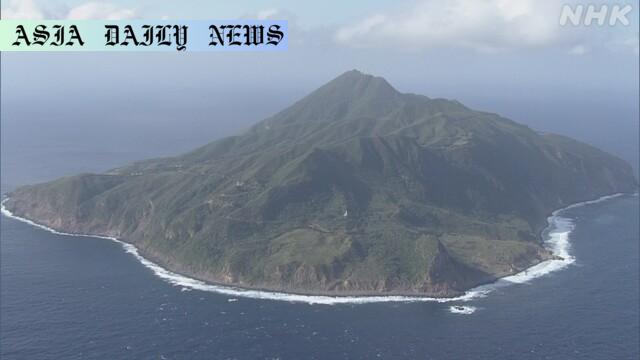Earthquakes: Authorities warn of continued seismic activity in Japan’s Tokara region, urging caution after 1,900 tremors since June 21.

Massive Seismic Activity Rocks Japan’s Tokara Island Chain
The Tokara Islands, located in Kagoshima Prefecture in southwestern Japan, have been experiencing significant seismic activity since June 21, 2023. In a span of a few weeks, the region has been rattled by 1,900 tremors perceptible to humans. The unprecedented level of tectonic activity has raised concerns among residents and authorities, pushing officials to issue warnings about potential future quakes with intensities reaching up to lower 6 on the Japanese seismic intensity scale, which ranges from 0 to 7.
On July 3, the region was jolted by a powerful earthquake measuring lower 6 in intensity, marking the largest quake since the onset of heightened seismic activity in June. This incident further underscores the escalating geological disturbance in the Tokara island chain. The Japan Meteorological Agency has advised caution as seismic activity persists, highlighting the importance of remaining vigilant and prepared for future events of similar magnitude.
Evacuations and Local Efforts to Ensure Safety
In response to this ongoing crisis, Toshima Village officials have taken proactive steps to ensure the safety of local residents. Currently, 64 residents of Akuseki-jima and Kodakara-jima have been evacuated and are awaiting determination of when it will be safe to return to their homes. Despite their displacement, many residents express concern about the long-term implications of residing in a geologically active area. Authorities are closely monitoring seismic activity and plan to decide by July 17 on repatriating evacuees, provided there are no further quakes measuring at least intensity level 4 for five consecutive days.
In addition to these efforts, nurses and support staff have been deployed to aid and monitor approximately 60 residents who have chosen to remain on the two islands. Community solidarity and administrative efforts offer hope and a measure of stability amidst this tense situation.
A History of Seismicity in the Tokara Region
The Tokara Islands are no stranger to seismic events. Historical data indicates that the region has experienced bouts of heightened tectonic activity in previous years, notably in 2021 and earlier in 2023. However, the current wave of tremors surpasses prior episodes in both frequency and intensity. The geological forces driving these quakes appear to have intensified, leading experts to closely monitor plate movements along tectonic boundaries in the region.
Experts suggest that seismic clusters like these could be warning signs of larger, more destructive earthquakes. The situation serves as a reminder of the unpredictable and uncontrollable forces of nature that shape our planet. Local governments and disaster response teams continue to emphasize preparedness, urging residents to remain alert and have contingency plans in place.
Adapting to Life Amidst Seismic Uncertainty
The ongoing seismic activity in the Tokara Islands highlights the challenges faced by communities living in earthquake-prone areas. The psychological toll on residents, coupled with concerns about infrastructure damage, economic losses, and the disruption of daily life, is significant. Children, elderly citizens, and vulnerable populations are especially affected, as extended displacement and uncertainty pose hurdles to recovery and resilience.
Mitigating such challenges calls for collaborative efforts between government agencies, public institutions, and scientific researchers. Developing advanced early warning systems, ensuring robust seismic-resistant building codes, and allocating adequate resources for emergency management are vital for safeguarding lives and livelihoods. Community-level education on earthquake preparedness further empowers individuals to respond effectively in times of crisis.
Commentary
Reflecting on Japan’s Seismic Risks: Lessons from Tokara
The recent spate of earthquakes rocking Japan’s Tokara Islands serves as both a warning and a lesson for communities prone to natural disasters. These events underscore how the power of nature can disrupt lives and test our resilience. What’s evident is the critical need for preparedness, community solidarity, and proactive government measures in the face of such unpredictable natural phenomena.
Protecting Vulnerable Communities
One cannot help but feel for the residents of the Tokara Islands. Forced to evacuate their homes and live in uncertainty, these individuals face immense emotional and physical challenges. It is essential that local and national authorities provide not only logistical support but also emotional reassurance to those affected. The deployment of nurses and staff to help those who remain on the islands is commendable, reflecting a collective effort to prioritize safety and health during these tense times.
Learning From Nature’s Warnings
The heightened seismic activity in Tokara also brings to light the importance of learning from such events. Japan’s history of earthquakes has equipped it with some of the most advanced disaster response frameworks in the world. But every new crisis presents an opportunity to refine and improve existing systems. Whether it’s through advancements in early warning systems, stricter building codes, or community-wide earthquake drills, there is always room for progress.
A Call for Global Solidarity
Looking at the situation more globally, the Tokara earthquakes remind us of our shared vulnerability to natural disasters. While Japan takes steps to mitigate and manage the impact of its seismic activity, other nations should also remain vigilant about their own preparedness. Natural disasters do not discriminate and can affect any country at any time. Sharing knowledge, expertise, and resources internationally can help create a more resilient world.
In conclusion, while the earthquakes in the Tokara Islands highlight the unpredictability of nature, they also demonstrate the strength and resolve of humanity in the face of adversity. By working together as communities, governments, and global citizens, we can overcome these challenges and build a safer and more united future.


